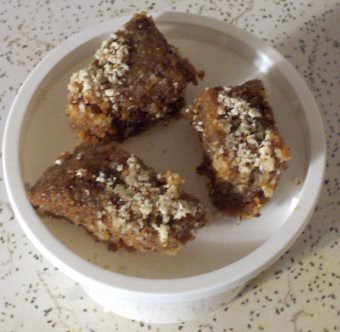
The mystery ingredient is khoa, also known as mawa or khoya. Khoa is made of milk (buffalo milk, traditionally), cooked for hours on a low flame until the liquids evaporate. The milk sugars caramelize and the proteins solidify. Think of it as a solid cake of dulce de leche without the sugar, or an unsalted gjetost. That’s pretty much what it tastes like too, almost cheese-like with a caramel flavor that is so subtly sweet as to not be sweet at all.
Khoa is the basis for many traditional Indian sweets, among them burfi, a treat similar to fudge. To make burfi, grate a cake of khoa into a large oiled wok or pot and add sugar and a pinch or two of ground cardamom. Cook until the sugar melts and the khoa solidifies again. Then remove the mixture from the heat and spread onto a greased tray. Decorate with ground pistachio nuts and the traditional edible silver leaves. Alternatively, you can mix in ground nuts just after removing the burfi from the heat. I mixed in ground almonds, and then sprinkled the top of my burfi with ground almonds as well. Cut the burfi into very small pieces, as a little bit can go a long way.
The result is an interesting take on caramelized desserts. The texture is distinctly fudge-like, but the flavor is a deep caramel, and very sweet from the added sugar. Cardamom offsets the sweetness somewhat, and adds another taste dimension that complements the nuts with its spiciness while underscoring the mellow burnt sugar flavor of the khoa.
I’m not sure I got the texture quite right, but all in all, these burfi are completely snackable. Perfect for a little something sweet after dinner. Or lunch. Or breakfast, with a mug of strong, hot coffee.
